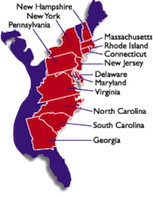We Don’t Need Learning Styles
A MiddleWeb Blog
LEARN MORE: Also see Elizabeth Stein’s April 2021 post “Students Can Reach Beyond Their Learning Preferences” for her current thinking on this topic and her ideas about adding dimension and challenge while honoring students’ favorite ways of learning.

Headlines such as Learning Styles Debunked and Learning Styles Re-evaluated hit the educational scene back in 2009. I remember going from link to link while my thoughts ranged from intrigue to skepticism. I just couldn’t wrap my mind around the attack on the learning style theory that I was trained to believe. Could it really be true that the theory I thought about every day as I considered the needs of my students was a fallacy?
For quite awhile I just couldn’t buy into it. It wasn’t until I began to read the work of cognitive psychologist Daniel Willingham that I started to make friends with the idea. And now, nearly five years later, after further study, research and new knowledge gained through my investigation of the Universal Design for Learning, I have put the pieces together.
With all due respect to the skeptics out there (I understand that many educators really “own” this idea), the learning style theory just doesn’t play a major role in my thinking as a teacher anymore. Have I shocked anyone? Allow me to connect all the dots…
Perspective shift
As far back as 2005, cognitive psychologist Dr. Daniel Willingham starting shaking the education tree with articles such as this one making the outrageous claim that learning styles simply do not exist. It caused some stir, but I remember most teachers I knew just blew it off as crazy. It wasn’t until I watched this video clip in 2008 that I began to think, Hey, I should really keep an open mind about this. It seemed to connect with some of my own experiences in the classroom. But as I say, until I really started digging into what Willingham was saying, the puzzle pieces didn’t all start clicking together.
The short version: All people learn differently—no one is arguing that. As Willingham explains, some learners are strong visual thinkers and some are better at remembering auditory stimuli. But it’s what happens in schools when these differences are “recognized” that’s all wrong.
Those students who are pegged by teachers as visual or auditory learners have the potential to become limited in their views of themselves as learners. Let me explain. For the learning style theory to be true, an auditory learner would always learn best through hearing the sounds of words, for example. The truth is that sometimes all of us need visual, auditory, or kinesthetic cues.

The dangers that come from believing in the learning style theory can occur when teachers hear, for example, that a student is a kinesthetic learner, so they make sure to include manipulatives in a lesson. Yet sometimes the manipulatives can distract students from the focus of the lesson. This may result in the teacher saying, “I don’t know why he still doesn’t get it, I used manipulatives to meet his needs.”
In these examples, it was the context of the particular lesson and/or the particular environment — not learning styles — that needed to be in focus.
Rather than adhering to the learning style theory, I have come to see that learning is flexible and teachers can meet the variable needs of students through these principles of a universal design for learning. I mentioned in my last post that I believed that as teachers make the instructional shifts with the Common Core, they must also make what I call the perspective shifts. It doesn’t make sense to peg individuals as one type of learner or another. As Willingham states, “We’re really asking students to remember meaning. Most of what we want students to learn isn’t sound or visually based…it’s meaning based.”
Is anyone with me during this Aha moment? Do you see the potential for this perspective shift?
That elephant in the school

Willingham claims that the learning style theory seems so right because:
1. A large percentage of people have believed in it for so long.
2. Part of the theory is right — people do learn in different ways. But it’s the pegboard way these differences are addressed in the classroom that is wrong.
3. When the belief in the learning style theory is present, a person will continue to interpret future situations (especially ambiguous ones) as consistent with the theory. If you believe something to be true (and decline to consider contradictory evidence), you will have a strong tendency to interpret situations to be consistent with your belief.
I’ve asked a few learning-style diehards why they believe in the theory. Here’s the general response, I know my students, and no one can tell me that they do not have individual learning styles. Here’s the catch…they DO.
But the diehards aren’t paying close attention: Willingham and other thought leaders in this area are not denying that students learn differently. They are saying that we need to change our perspective about what “different” means for teaching and learning. One thing it doesn’t mean is pigeon-holing students into a single learning “box.”
 The way I see it
The way I see it
The learning style theory is not the glue that holds my lessons together. The way I meet the needs of diverse learners is by focusing on learner variability and providing access to the curriculum so that students may construct meaning in every way that works for them.
It’s not about creating lessons for specific learning styles. It’s about creating accessible learning environments by removing barriers, including those that cut students off from learning opportunities. Here’s a quote that sums it all up for me:
Good teaching is good teaching and teachers don’t need to adjust their teaching to individual learning styles.” ~Daniel Willingham
Check out this book review for more details about Willingham’s ideas for creating meaningful learning experiences. And for more information about how to effectively address student’s individual needs check out the CAST website.
So how do you see it? Are you a learning style believer? Or are you ready for a perspective shift — or willing to offer your defense of the learning style theory? Let’s talk!



































Absolutely! Learning styles shouldn’t be about how we put the information in–input should ALWAYS strive to be multi-sensory. VAK should be making sure that kids have a variety of different mnemonics to file that knowledge and pull it OUT most effectively & efficiently.
The Pashler, et.al. study did not evaluate was variance between input vs. retrieval in learning styles. His learning theory analysis was based on the idea that learning styles should help teachers better INPUT information. In fact, the study even makes “a basic distinction between what we call the existence of study preferences and what we call the learning-styles hypothesis.” (p108) Then, you look at a meta-analysis of 34 studies involving the use of VAK mnemonic strategies with students who have learning disabilities, the overall effect size was a very strong 1.62 (Mastropieri, Sweda, & Scrugs, 2000).
If a student is struggling, keying into learning style preferences may help a teacher identify mnemonics that could help that student better recall the information–but definitely don’t skimp on curriculum design that encompasses all the modalities when teaching new concepts to your students!
Jen, thanks for your informative and insightful post. Yes! The way we present the information to students should always be multi-sensory. But I do not like to describe it that way. It’s a matter of semantics. But I’ve noticed that the word “multi-sensory” trips teachers back into thinking inside a narrow learning style theory box. Or they gloss over the need to present information through multiple pathways.
As you say, we should be making sure to present students with a variety, which is why UDL is perfect! It’s about providing multiple means of representation, engagement and expression. Students’ individual strengths and needs will be addressed while keeping a focus on the meaning of each lesson.
Thanks for clarifying that there is a place to supplement students’ learning needs through their personal strengths and preferences through mnemonics.
For those who would like to learn more about the research Jen referenced, check out these links:
Pashler et al:
http://www.vashonsd.wednet.edu/mcmurray/science/justin/Resources/HOM/Pashler_et_al_PSPI_9_3.pdf
More about mnemonics:
http://www.ldonline.org/article/15577/
What about interest and motivation? There may be no barriers in place that prevent learning, but the students aren’t interested or motivated by the way in which material is presented. I recall a four year old student to whom I was teaching letter identification while using manipulative cards for pick up when I named the letter. This was certainly more interesting than a worksheet, but still not an enticing activity for him. I gave him a bean bag and asked him to toss it to the letter on the board. He then became very engaged in the activity and began to learn. Was he a kinesthetic learner or was the activity just more interesting and motivating for him because he enjoys moving? If we think about the multiple intelligences in terms of interest and motivation, do they in turn impact student’s ability to learn? In order for student learning to take place, they certainly need to be “engaged”!
willmss2013, I’m really excited about your response—you give a lot for readers to think about!
You also provide a great example of the value of a universal design for learning approach.
Check out this link that explains the alignment of Mulitple Intelligences, Differentiated Instruction, and UDL:
The intersection of initiatives— http://www.cast.org/teachingeverystudent/ideas/tes/chapter1_4.cfm
Also, the three brain networks and UDL principles can help to clarify the role of motivation and interest:
http://www.cast.org/udl/
I think that you provided multiple means of representing the letters as well as flexibility in the ways he was able to express his knowledge. He was an active participant in the learning process. He was connected and, therefore, engaged. That’s what it’s all about!
Let’s continue this conversation…
Part 1: Great post! Thanks for the link to the video. I really hadn’t given learning style theory too much thought. Truth be told I was thinking of learning “styles” more as a flexible way to support students than as putting them in a box for all time.
I agree with you that addressing learner variability through applying UDL principles would be much more effective than using learning style theory.
Perhaps learning style theory inhibits learning if applied exactly as it is stated but does teacher awareness of learning style theory inhibit or support learning? Was learning style theory what initially got educators thinking about presenting and expressing information differently? Do teachers who use the concepts of learning style theory end up engaging more students?
Part 2 – The underlying question I’m left with is does learning style theory inhibit progress for UDL to become more “mainstream”? Do we buy in to it because it is simple to define and apply while UDL isn’t? If that is the case, is there a way to more simply define and apply UDL?
In sections of this post: http://eliminatingthebox.blogspot.ca/2013/07/reflecting-on-universal-design-for.html I wrote about Denise DeCoste visiting (via Skype) a class that I was taking this summer and speaking to us about a process of implementing UDL that she was involved in. What I liked about it was that they made it simple. They defined 4 essential elements of UDL and then started with the idea of providing choices rather than starting with technology. In fact, they didn’t look at technology until the teachers were comfortable with more flexible approaches and then brought it in. On this note, the fact that teachers are familiar with the idea of learning styles (even though they may not be familiar with the full theory behind it) might actually help in making that first step related to choice.
Hello @mom2mikey! It was great to chat with you on Twitter yesterday! I am glad you brought our conversation to this forum—it gives others a chance to join in on a great discussion. Readers, please add your voice!
@mom2mikey, I love your stream of questions—it’s a great way to push our thinking along.
I think teachers use the term learning styles loosely by giving credit to the idea of learning styles for the success of a lesson when the success of a lesson is due to an accessible curriculum and meaningful learning activities, so students may connect with it.
I think the learning style theory inhibits teachers’ views on the way their students think. More importantly, I think the learning style theory inhibits the way we guide our students to view themselves as learners. It then becomes a self-fulfilling prophecy that may limit learning experiences. We should be guiding students to be flexible thinkers—ready to learn, connect, and achieve to their personal best in a variety of situations.
I’m looking forward to reading your blog and continuing our discussions.
Hi, I like how you presented this, and understand the complexity of getting people to contemplate or let go of deeply held beliefs.
In the same vein as getting to grasp learning styles/types better, (beyond the basic level of understanding), imagine trying to get teachers (or anyone), to release their stranglehold on letter grading and evaluation. The reasoning side of this problem is the same, but the damage done by letter grades cannot easily be contemplated.
In the way, have you ever tried to convince anyone that IQ testing is not valid, and why?
The learning styles, visual, aural, verbal (reading/writing) and kinesthetic (Chick, 2010), are more akin to information processing frequencies or channels (IPFs) or IPCs) to which an individual may possess a natural or learned alignment. It is likely that most people possess multiple alignments, which may allow for an expansive learning experience.
Reference
Chick, N. (2010). Learning Styles. Vanderbilt University Center for Teaching. Retrieved July 15, 2023 from https://cft.vanderbilt.edu/guides-sub-pages/learning-styles-preferences/.